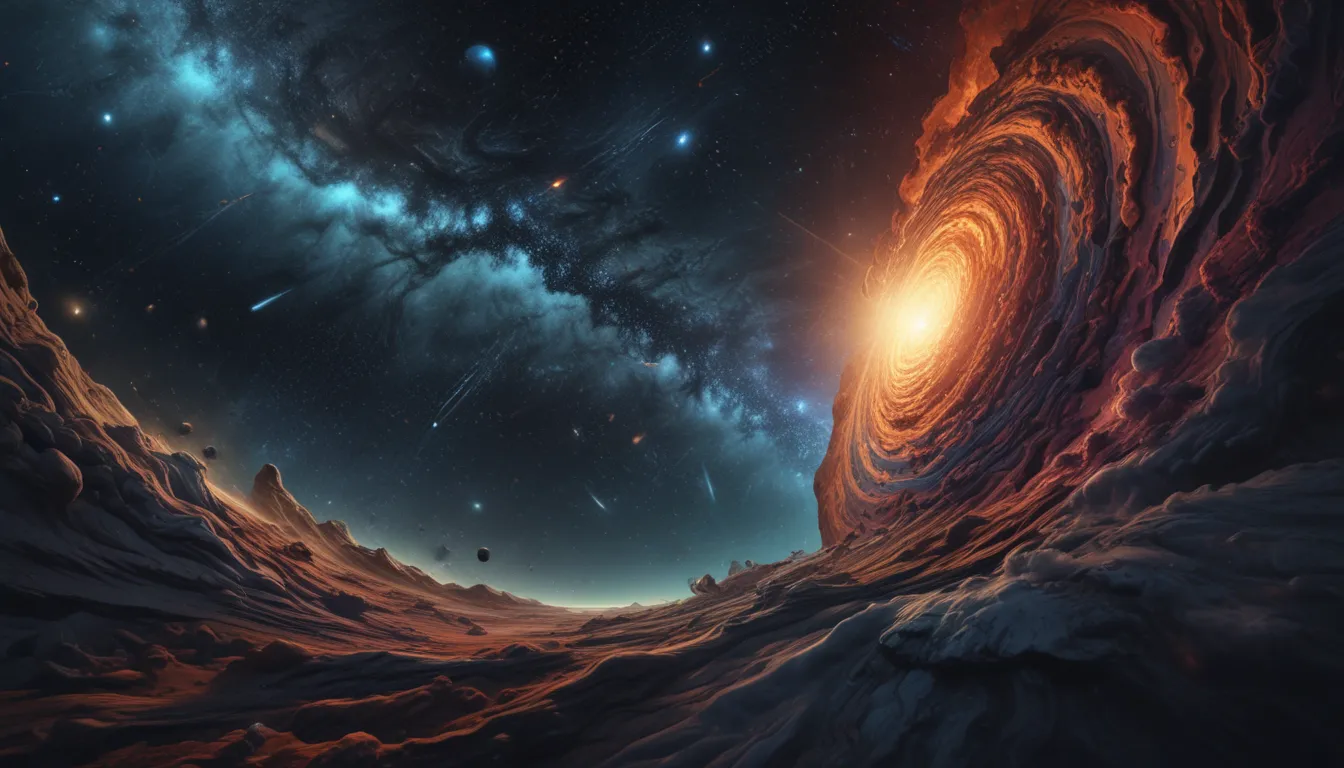The pictures we use in our articles might not show exactly what the words say. We choose these pictures to make you interested in reading more. The pictures work together with the words but don’t take their place. The words still tell you the important facts.
Embark on a cosmic journey through the ethereal realms of the universe as we delve into the enigmatic phenomenon known as Cosmic Background Radiation. This ancient light, a lingering remnant of the Big Bang, holds the key to unraveling the mysteries of cosmic formation and evolution. Join us as we unearth 20 unbelievable facts that will expand your understanding of the cosmos and shine a light on the wonders of the universe.
Unveiling the Cosmic Background Radiation
The Cosmic Background Radiation, also known as the CMB, stands as the oldest light in the Universe, offering a glimpse into the early stages of cosmic formation and supporting the Big Bang theory. By studying the CMB, scientists gain insights into dark matter, dark energy, and the Universe's infancy, revolutionizing our understanding of the cosmos.
Discovering the Cosmic Background Radiation
In 1964, astronomers Arno Penzias and Robert Wilson stumbled upon the Cosmic Background Radiation by accident while working on a radio antenna. This low-level noise detected from all directions unveiled the afterglow of the Big Bang itself, marking a groundbreaking discovery in the realm of astrophysics.
The Ancient Glow of the CMB
The Cosmic Background Radiation emerged just 380,000 years after the Big Bang, making it the oldest light in the Universe. This ancient glow provides crucial insights into the early stages of cosmic evolution, offering a window into the dawn of the cosmos.
The Cosmic Symphony of Uniformity
A remarkable aspect of the CMB is its near-uniformity across the sky. Appearing nearly the same in every direction, the Cosmic Background Radiation showcases slight temperature variations that hint at the seeds of structure formation in the early Universe.
The Invisible Spectacle
Despite its grandeur, the Cosmic Background Radiation is not visible to the naked eye. This ancient light exists in the form of microwaves with wavelengths around a millimeter, detectable only through specialized telescopes and instruments.
Echoes of the Big Bang
The Cosmic Background Radiation serves as a cornerstone in supporting the Big Bang theory. Its characteristics, such as temperature and uniformity, align closely with the predictions made by this transformative theory, shedding light on the origins of our vast universe.
Unveiling Cosmic Secrets
Embedded within the Cosmic Background Radiation are tiny temperature fluctuations, measured in millionths of a degree. These fluctuations unveil the density variations that set the stage for the formation of galaxies, galaxy clusters, and the majestic structures of the cosmos.
Mapping the Cosmic Landscape
Through the study of the CMB, astronomers have unlocked a wealth of knowledge about the large-scale structure of the Universe. The temperature fluctuations within the Cosmic Background Radiation offer valuable insights into the distribution of matter and the intricate dance of cosmic structures.
The Chilling Temperature of the CMB
At a mere 2.7 Kelvin above absolute zero, the Cosmic Background Radiation boasts an incredibly cold temperature. This chilling relic from the early Universe serves as a testament to the transformative events that shaped the cosmos.
Tools of Cosmic Revelation
To detect and study the Cosmic Background Radiation, scientists employ specialized instruments such as the Wilkinson Microwave Anisotropy Probe (WMAP) and the Planck satellite. These cutting-edge tools capture the faint microwave signals emitted by the CMB, unraveling its ancient secrets.
The Cosmic Shift of Redshift
As a result of the Universe's expansion, the wavelengths of the Cosmic Background Radiation have been stretched, leading to a phenomenon known as redshift. This cosmic shift enables astronomers to measure the expansion rate of the Universe, shedding light on its early evolution.
Unveiling the Age of the Universe
Through the properties of the Cosmic Background Radiation, scientists have estimated the age of the Universe to be around 13.8 billion years. This groundbreaking insight, derived from CMB data, offers a glimpse into the vast expanse of cosmic time.
Cosmic Insights into Dark Matter and Dark Energy
Studying the CMB provides a gateway to understanding the enigmatic realms of dark matter and dark energy. These mysterious components, comprising the majority of the Universe, offer tantalizing clues that refine existing models and theories in cosmology.
The Cosmic Cradle of Inception
Observing the Cosmic Background Radiation gives us a profound glimpse into the Universe's infancy. The minute temperature fluctuations and density variations captured within the CMB paint a vivid picture of the early cosmos, illuminating the celestial processes that birthed galaxies and cosmic marvels.
Unearthing the Seeds of Cosmic Structure
Within the Cosmic Background Radiation lie the seeds of cosmic structure. These subtle temperature variations unveil the primal irregularities from which galaxies, galaxy clusters, and superclusters emerged, shaping the tapestry of the cosmos.
Cosmic Revelations and Inflated Realities
The CMB plays a pivotal role in shaping our understanding of inflation, a theory that elucidates the rapid expansion of the Universe in its early moments. Precise measurements of the Cosmic Background Radiation bolster the predictions of inflation, offering crucial insights into the conditions following the Big Bang.
The Radiant Spectrum of the CMB
The Cosmic Background Radiation adheres to a unique blackbody spectrum, known as the Planckian distribution. This distinctive spectrum's shape and intensity provide valuable insights into the physical conditions during the epoch of recombination, unraveling cosmic mysteries.
A Glimpse of Cosmic Genesis
Originating just 380,000 years after the Big Bang, the Cosmic Background Radiation offers a mesmerizing glimpse of the Universe's first light. By studying this ancient radiation, astronomers unearth details about the early composition and evolution of the cosmos, embarking on a cosmic odyssey through time.
The Homogeneity of Cosmic Majesty
The uniformity and isotropy of the Cosmic Background Radiation affirm the homogeneity of the Universe on vast scales. The data gleaned from the CMB reinforces the notion that, on average, the Universe maintains consistent properties in every direction, sparking wonder and curiosity.
The Cosmic Enigma of Dark Matter
The measurements derived from the Cosmic Background Radiation provide compelling evidence for the existence of dark matter. This elusive form of matter, imperceptible to light, exhibits gravitational effects that align with the distribution of matter inferred from CMB data, unveiling the mysteries of the cosmic tapestry.
Cosmic Revolution and the Tapestry of Understanding
The discovery and exploration of the Cosmic Background Radiation have heralded a revolution in the field of cosmology. These ancient whispers from the cosmos have bestowed deep insights into the origins, evolution, and composition of the Universe, paving the way for groundbreaking discoveries and advancements in our comprehension of the cosmic theater.
Conclusion: Unveiling the Cosmic Tapestry
In conclusion, the cosmic background is a fascinating and mysterious phenomenon that continues to captivate scientists and enthusiasts. The 20 unbelievable facts about the cosmic background radiation have illuminated its origins, properties, and significance in our understanding of the universe. From its status as a relic of the Big Bang to its role in confirming the theory of cosmic inflation, the cosmic background radiation holds invaluable insights into the earliest moments of our universe. As we unravel the cosmic tapestry shrouded in the whispers of the cosmic background radiation, the potential for groundbreaking discoveries and mind-boggling revelations remains ever-present on the horizon.
FAQs: Voyage through Cosmic Enlightenment
-
What is the cosmic background?
The cosmic background refers to the faint radiation that fills the universe, a remnant from the early stages of the universe, also known as the afterglow of the Big Bang. -
How was the cosmic background discovered?
The cosmic background radiation was accidentally discovered in 1965 by Arno Penzias and Robert Wilson, who were trying to eliminate interference in their radio telescope observations. -
What is the significance of the cosmic background?
The cosmic background radiation is crucial in confirming the Big Bang theory and providing insights into the composition, structure, and evolution of the universe. -
How is the cosmic background studied?
Scientists study the cosmic background through specialized instruments and experiments, such as the Wilkinson Microwave Anisotropy Probe (WMAP) and the Planck satellite. -
Are there any variations in the cosmic background?
Yes, the cosmic background radiation exhibits slight temperature variations, which help scientists understand the distribution of matter and energy in the universe. -
What is cosmic inflation?
Cosmic inflation is a theoretical concept suggesting that the universe underwent rapid expansion shortly after the Big Bang, explaining the uniformity and isotropy of the cosmic background radiation. -
How does the cosmic background help in studying dark matter?
The cosmic background radiation enables scientists to map the gravitational effects of dark matter on the large-scale structure of the universe. -
Can we see the cosmic background with the naked eye?
No, the cosmic background radiation is in the microwave part of the electromagnetic spectrum and cannot be seen directly with the naked eye. -
Are there any future missions planned to study the cosmic background?
Yes, the James Webb Space Telescope (JWST) and the upcoming European Space Agency’s Euclid mission are expected to provide further insights into the cosmic background and its implications. -
How does the cosmic background support the existence of dark energy?
The cosmic background radiation helps in studying the expansion rate of the universe, providing evidence for the existence of dark energy, a mysterious force driving the accelerating expansion.
Embark on a cosmic odyssey through the mysteries of the universe as we unravel the secrets of the Cosmic Background Radiation, shedding light on the ancient whispers that shape the cosmic tapestry. Join us in exploring the enigmatic realms of cosmic formation, evolution, and composition, guided by the celestial light that illuminates the path to cosmic enlightenment. As we peer through the veil of the cosmos, let the wonders of the Cosmic Background Radiation inspire a sense of awe and wonder, igniting a curiosity that transcends the boundaries of space and time.






